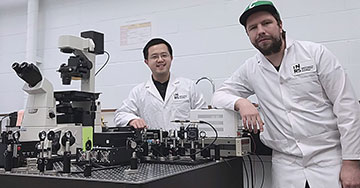
Professor Jinyang Liang and doctoral student Patrick Kilcullen in their laboratory at the Énergie Matériaux Télécommunications Research Centre of the INRS. [Image: INRS]
Single-pixel imaging is growing in popularity, with broad applications in the non-visible spectrum, where dedicated cameras remain difficult and expensive to produce. Generally, the technique employs 2D spatial patterns of light and a single-pixel detector to reconstruct an image.
Now, researchers in Canada have developed a fast and reconfigurable single-pixel camera that combines a digital micromirror device with laser scanning hardware (Nat. Commun., doi: 10.1038/s41467-022-35585-8). With the help of a lightweight reconstruction algorithm, the new camera is capable of streaming real-time video at 100 frames per second (fps), and up to 12,000 fps offline.
Imaging with just one pixel
Single-pixel cameras produce images without the use of a traditional 2D sensor, instead leveraging light modulation and a much more economical single-pixel detector. The unique approach has the ability to fill a niche in situations where building an entire array of detectors would be impractical. Such devices have been implemented in time-of-flight 3D profilometry, single-photon imaging, terahertz imaging and other applications.
They work by reflecting an image off a digital micromirror device (DMD)—an array of microscopic mirrors that can be tilted at will—which allows only some of the light to be diverted to the detector at any given time. By randomly changing the arrangement of micromirrors while recording the sensor output, a compressed-sensing algorithm can be used to reconstruct the image.
“Projecting these many 2D spatial patterns still takes some time, even if we use the most advanced DMD,” said Jinyang Liang, an associate professor at the Institut National de la Recherche Scientifique (INRS) of the Université du Québec. “So, the 2D imaging speeds in most existing single-pixel cameras are clamped under 100 fps, precluding them from high-speed imaging.”
Fast laser scanning
Liang and his colleagues aimed to boost the overall speed with a novel technique, which they dubbed single-pixel imaging accelerated via swept aggregate patterns (SPI-ASAP). The SPI-ASAP system still shares the same operating principle as other single-pixel cameras, but it adds an innovative laser scanning platform.
First, a special design is used to squeeze many encoding patterns into a single mask, called an aggregate pattern, which is displayed on the DMD. Fast laser scanning rapidly deploys individual encoding masks as optically selected sub-regions of the larger aggregate pattern.
“In this way, pattern aggregation enhances single-pixel imaging data acquisition rates to more than 100 times above the limitations of DMD-only modulation,” said Liang. “At the same time, we can still retain the high pixel count and flexibility of pattern display with DMDs.”
Seeing beyond visible light
The researchers also developed a fast compressed-sensing reconstruction algorithm with full compatibility with parallel computing for real-time visualization. All in all, the SPI-ASAP system projects encoding patterns at a rate of up to 14.1 MHz, allowing for reconfigurable 2D imaging offline at up to 12,000 fps, and real-time video operation at 100 fps.
Liang foresees that the current system will contribute to the study of combustion phenomena and the characterization of optical properties of nanomaterials.
“We believe that SPI-ASAP will shine even brighter in applications that use non-visible spectral ranges,” Liang said. “For example, SPI-ASAP with an infrared light source will enable fast hazardous gas detection and has great potential to speed up 2D terahertz imaging.”
The authors have provided reconstructed videos from SPI-ASAP system tests:

